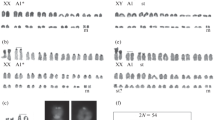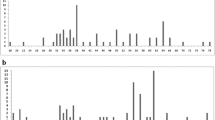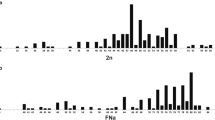Abstract
Ctenomys lami Freitas, 2001 is an endemic species of rodent inhabiting the Coastal Plain of southern Brazil, along a narrow line of old dunes formed in the Pleistocene. This species has five different diploid numbers (2n=54, 55a, 55b, 56a, 56b, 57 and 58) and ten different autosomal fundamental numbers (FNa=74, 75, 76, 77, 78, 79, 80, 81, 82, and 84). In a sample of 102 specimens, the combined 2n and FNa formed 26 different karyotypes. The diploid number variation was due to Robertsonian rearrangements that occur in pairs 1 and 2, and the variation of NFas was due to pericentric inversions. The distribution of diploid number variation along the 78 km line of collection sites reveals four population blocks: block A with 2n=54, 55a, and 56a; block B with 2n=57 and 58; block C with 2n=54 and 55a; and block D with 2n=56b and 55b. The inversion system lacks geographic structure with a random distribution of inversions along the population blocks. A very narrow hybrid zone is hypothesized between blocks A and B. Blocks B and C are separated by a geographic barrier, and another hybrid zone is found between blocks C and D. My findings suggest that this species is undergoing a process of speciation due to geographic isolation.
Similar content being viewed by others
References
Ford C. E. and Hamerton J. L. 1957. A colchicine hypotonic citrate squash sequence for mammalian chromosomes. Stain Tech 31: 247–251.
Freitas T. R. O. 1994. Geographical variation of heterochromatin inCtenomys flamarioni (Rodentia-Octodontidae) and its cytogenetic relationships with other species of the genus. Cytogenetic Cell Genetics 67: 193–198.
Freitas T. R. O. 1997. Chromosome polymorphism inCtenomys minutus (Rodentia-Octodontidae). Revista Brasileira de Genética 20: 1–7.
Freitas T. R. O. 2001. Tuco-tucos (Rodentia-Octodontidae) in southern Brazil:Ctenomys lami spec. nov. separated fromC. minutus Nehring 1887. Studies Neotropical Fauna and Environment 36: 1–8.
Freitas T. R. O. and Lessa E. P. 1984. Cytogenetics and morphology ofCtenomys torquatus (Rodentia-Octodontidae). Journal of Mammalogy 65: 637–642.
Freygang C. C., Marinho J. R. and Freitas T. R. O. 2004. New karyotypes and some considerations about the chromosomal diversification ofCtenomys minutus (Rodentia: Ctenomyidae) on the coastal plain of the Brazilian state of Rio Grande do Sul. Genetica 121: 125–132.
Garcia L., Ponsá M., Egozcue J. and Garcia M. 2000a. Cytogenetic variation inCtenomys perrensis (Rodentia, Octodontidae). Biological Journal of Linnean Society 71: 615–624.
Garcia L., Ponsá M., Egozcue J. and Garcia M. 2000b. Comparative chromosomal analysis and phylogeny in fourCtenomys species (Rodentia, Octodontidae). Biological Journal of Linnean Society 69: 103–120.
Gava A. and Freitas T. R. O. 2003. Inter and intra specific hybridization in tuco-tucos (Ctenomys) from Brazilian Coastal Plains (Rodentia-Ctenomyidae). Genetica 119: 11–17.
Gava A. and Freitas T. R. O. 2002. Characterization of a hybrid zone between chromosomally divergent populations ofCtenomys minutus (Rodentia: Ctenomyidae). Journal of Mammalogy 83: 843–851.
Gimenez M. D., Contreras J. R. and Bidau C. J. 1997. Chromosomal variation inCtenomys pilarensis a recently described species from eastern Paraguay (Rodentia, Ctenomyidae). Mammalia 61: 385–398.
Howell W. M. and Black D. A. 1980. Controlled silver-staining of nucleolus organizer regions with a protective colloidal developer: A 1-step method. Experientia 36: 1014–1015.
Kiblisky P., Brum-Zorrilla N., Perez G. and Saez F. A. 1977. Variabilidade cromosómica entre diversas poblaciones uruguayas del roedor cavador del géneroCtenomys (Rodentia-Octodontidae). Mendeliana 2: 85–93.
Massarini A. I., Barros M. A., Ortells M. O. and Reig O. A. 1991. Evolutionary biology of fossorial Ctenomyine rodents (Caviomorph: Octodontidae). I. Chromosomal polymorphism and small karyotypic differentiation in Central Argentinian populations of tuco-tucos. Genetica 83: 131–144.
Massarini A. I., Dyzenchuz F. J. and Tiranti S. I. 1998. Geographic variation of chromosomal polymorphism in nine populations ofCtenomys azarae, tuco-tucos ofCtenomys mendocinus (Rodentia-Octodontidae). Hereditas 128: 207–211.
Michalakis Y. and Excoffier L. 1996. Generic estimation of population subdivision using distances between alleles with special interest to microsatellite loci. Genetics 142: 1061–1064.
Moreira D. M., Franco M. H. L. P., Freitas T. R. O. and Weimer T. A. 1991. Biochemical polymorphism and phenetic relationships in rodents of the genusCtenomys from Brazil. Biochemical Genetics 29: 601–615.
Novello A. F. and Lessa E. P. 1986. G-banded homology in two karyomorphs of theCtenomys pearsoni complex (Rodentia: Octodontidae) of neotropical fossorial rodents. Zeitschrift für Säugetierkunde 51: 378–380.
Ortells M. O., Contreras J. R. and Reig O. A. 1990. NewCtenomys karyotypes (Rodentia, Octodontidae) from north-eastern Argentina and from Paraguay confirm the extreme chromosomal multiformity of the genus. Genetica 82: 189–291.
Raymond M. and Rousset F. 1995. GENEPOP (Version 1.2): Population Genetics Software for Exact Test Ecumenism. Journal of Heredity 86: 248–249.
Reig O. A. and Kiblisky P. 1969. Chromosome multiformity in the genusCtenomys (Rodentia: Octodontidae). Chromosoma 28: 211–244.
Reig O. A., Bush C., Ortells M. O. and Contreras J. R., 1990. An overview of evolution, systematic, population biology, cytogenetics, molecular biology and speciation inCtenomys. [In: Evolution of subterranean mammals at the organismal and molecular level. E. Nevo and O. A. Reig, eds]. Alan R. Liss, New York: 71–96.
Rieseberg L. 2001. Chromosomal rearrangements and speciation. Trends in Ecology and Evolution 16: 351–358.
Seabright M. 1971. A rapid banding technique for human chromosomes. Lancet II: 971–972.
Slamovits C. H., Cook J. A., Lessa E. P. and Rossi M. S. 2001. Recurrent amplifications and deletions of satellite DNA accompanied chromosomal diversification in South American tuco-tucos (GenusCtenomys, Rodentia: Octodontidae): A phylogenetic approach. Molecular Biology Evolutionary 18: 1708–1719.
Sumner A. T. 1972. A simple technique for demonstrating centromeric heterochromatin. Experimental Cell Research 75: 304–306.
Wahrman J., Richler C., Gamperl R. and Nevo E. 1985. Revisiting Spalax: mitotic and meiotic chromosome variability. Israel Journal of Zoology 33: 15–38.
Weir B. S. and Cockerham C. C. 1984. Estimating F-statistics for the analysis of population structure. Evolution 38: 1358–1370.
Wlasiuk G., Garza J. C. and Lessa E. P. 2003. Genetic and geographic differentiation in the Río Negro tuco-tuco (Ctenomys rionegrensis): inferring the roles of migration and drift from multiple genetic markers. Evolution 57: 913–926.
Author information
Authors and Affiliations
Corresponding author
Additional information
Associate editor was Joseph F. Merritt.
Rights and permissions
About this article
Cite this article
de Freitas, T.R.O. Ctenomys lami: The highest chromosome variability inCtenomys (Rodentia, Ctenomyidae) due to a centric fusion/fission and pericentric inversion system. Acta Theriol 52, 171–180 (2007). https://doi.org/10.1007/BF03194212
Received:
Accepted:
Issue Date:
DOI: https://doi.org/10.1007/BF03194212




